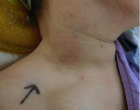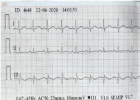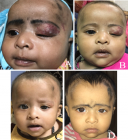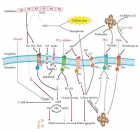Abstract
Review Article
COVID-19: The possible medical strategies
Mohamed SA Mohamed*
Published: 09 June, 2020 | Volume 4 - Issue 1 | Pages: 071-075
In late 2019, a pandemic crisis started in Wuhan, China, swept the whole world. The disease is caused by the SARS-CoV-19 virus that belongs to the corona family of viruses. The virus mainly caused failure of respiration, and led to many deaths worldwide. The main focus of research and medicine is to find more about the virus, as well as the development of effective preventive and therapeutic measures. While many trials and opinions have been published, which might support or contradict each other, this article tries to provide a simplified viewpoint about the disease. We highly recommend the therapeutic strategies to include drug combinations that can target the pathogenesis at many levels. For example, a combination of an effective anti-viral Remdesivir, soulable ACE2, and an immune modulator.
Read Full Article HTML DOI: 10.29328/journal.ijcv.1001018 Cite this Article Read Full Article PDF
Keywords:
COVID-19; SARS-CoV-2; Respiratory failure; Multi-organ failure
References
- Zhao W, Zhong Z, Xie X, Yu Q, Liu J, et al. Relation Between Chest CT Findings and Clinical Conditions of Coronavirus Disease (COVID-19) Pneumonia: A Multicenter Study. Am J Roentgenol. 2020; 214: 1072-1077. PubMed: https://www.ncbi.nlm.nih.gov/pubmed/32125873
- Atallah B, Mallah SI, Al–Mahmeed W. Anticoagulation in COVID-19. Eur Heart J Cardiovasc Pharmacother. pvaa 036. PubMed: https://www.ncbi.nlm.nih.gov/pubmed/32352517
- Wanga X, Yea Y, Gong H, et al. The effects of different angiotensin II type 1 receptor blockers on the regulation of the ACE-AngII-AT1 and ACE2-Ang(1–7)-Mas axes in pressure overloadinduced cardiac remodeling in male mice. J Molecular Cellu Cardiol. 2016; 97: 180-190.
- Esler M, Esler D. Can Angiotensin Receptor-Blocking Drugs Perhaps Be Harmful in the COVID-19 Pandemic? J Hypertens. 2020; 38: 781-782. PubMed: https://pubmed.ncbi.nlm.nih.gov/32195824
- Grein J, Ohmagari N, Shin D, et al. Compassionate Use of Remdesivir for Patients with Severe Covid-19. N Engl J Med. 2020; NE J Moa. 2007016. PubMed: https://pubmed.ncbi.nlm.nih.gov/32275812
- gov Identifier: NCT04317040
- gov Identifier: NCT04313322
- Fox RI. Mechanism of Action of Hydroxychloroquine as an Antirheumatic Drug. Semin Arthritis Rheum. 1993; 23(2 Suppl 1): 82-91. PubMed: https://pubmed.ncbi.nlm.nih.gov/8278823/
- Liu J, Cao R, Xu M, Wang X, et al. Hydroxychloroquine, a less toxic derivative of chloroquine, is effective in inhibiting SARS-CoV-2 infection in vitro. Cell Discovery. 2020; 6: 16. PubMed: https://pubmed.ncbi.nlm.nih.gov/32194981/
- gov Identifier: NCT04307693
- Molina JM, Delaugerre C, Le Goff J, Mela-Lima B, Ponscarme D, et al. No Evidence of Rapid Antiviral Clearance or Clinical Benefit With the Combination of Hydroxychloroquine and Azithromycin in Patients With Severe COVID-19 Infection. Med Mal Infect. 2020; 50: 384. PubMed: https://www.ncbi.nlm.nih.gov/pmc/articles/PMC7195369/
- Prestes TRR, Rocha NP, Miranda AS, et al. The AntiInflammatory Potential of ACE2/Angiotensin-(1-7)/Mas Receptor Axis: Evidence from Basic and Clinical Research. Curr Drug Targets. 2017; 18: 1301-1313. PubMed: https://pubmed.ncbi.nlm.nih.gov/27469342/
- Zhang H, Penninger JM, Li Y, Zhong N, Slutsky AS. Angiotensin-converting Enzyme 2 (ACE2) as a SARS-CoV-2 Receptor: Molecular Mechanisms and Potential Therapeutic Target. Intensive Care Med. 2020; 46: 586-590. https://pubmed.ncbi.nlm.nih.gov/32125455/
- Khan A, Benthin C, Zeno B, Albertson TE, Boyd J, et al. A Pilot Clinical Trial of Recombinant Human Angiotensin-Converting Enzyme 2 in Acute Respiratory Distress Syndrome. Crit Care. 2017; 21: 234. PubMed: https://pubmed.ncbi.nlm.nih.gov/28877748
- Hung IFN, Lung KC, Tso EV, Liu R, Chung TW, et al. Triple combination of interferon beta-1b, lopinavir–ritonavir, and ribavirin in the treatment of patients admitted to hospital with COVID-19: an open-label, randomised, phase 2 trial. The Lancet. 2020; 395: 1695-1704. PubMed: https://pubmed.ncbi.nlm.nih.gov/32401715/
Figures:
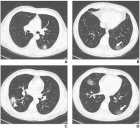
Figure 1

Figure 2
Similar Articles
-
Pseudoephedrine protects mice from infection of H1N1 virusZhongping Wu*,Li Deng,Chengzhi Chu,Xiaoyin Chen*. Pseudoephedrine protects mice from infection of H1N1 virus. . 2020 doi: 10.29328/journal.ijcv.1001008; 4: 014-020
-
Hypothesis about pathogenic action of Sars-COV-2Del Prete Salvatore*,Marasco Daniela,Sabetta Rosalaura. Hypothesis about pathogenic action of Sars-COV-2. . 2020 doi: 10.29328/journal.ijcv.1001009; 4: 021-022
-
The Psychology of the Common Cold and Influenza: Implications for COVID-19Andrew P Smith*. The Psychology of the Common Cold and Influenza: Implications for COVID-19. . 2020 doi: 10.29328/journal.ijcv.1001011; 4: 027-031
-
Yemen is free of COVID-19Hussein O Kadi*. Yemen is free of COVID-19. . 2020 doi: 10.29328/journal.ijcv.1001012; 4: 032-033
-
Exploring pathophysiology of COVID-19 infection: Faux espoir and dormant therapeutic optionsVinod Nikhra*. Exploring pathophysiology of COVID-19 infection: Faux espoir and dormant therapeutic options. . 2020 doi: 10.29328/journal.ijcv.1001013; 4: 034-040
-
COVID-19: Targeting the cytokine storm via cholinergic anti-inflammatory (Pyridostigmine)Ahmed H Osman*. COVID-19: Targeting the cytokine storm via cholinergic anti-inflammatory (Pyridostigmine). . 2020 doi: 10.29328/journal.ijcv.1001014; 4: 041-046
-
Identifying patterns in COVID-19: Morbidity, recovery and the aftermathVinod Nikhra*. Identifying patterns in COVID-19: Morbidity, recovery and the aftermath. . 2020 doi: 10.29328/journal.ijcv.1001016; 4: 056-064
-
Role of nanotechnology in diagnosing and treating COVID-19 during the PandemicAbdul Baset*,Abdul Waris,Muhammad Ali,Atta Ullah Khan,Asmat Ali. Role of nanotechnology in diagnosing and treating COVID-19 during the Pandemic. . 2020 doi: 10.29328/journal.ijcv.1001017; 4: 065-070
-
COVID-19: The possible medical strategiesMohamed SA Mohamed*. COVID-19: The possible medical strategies. . 2020 doi: 10.29328/journal.ijcv.1001018; 4: 071-075
-
Can house flies mechanically carry and/or transport sars-cov-2?Alfredo Montes*,Wilfrido Coronell,Rosa Baldiris. Can house flies mechanically carry and/or transport sars-cov-2?. . 2020 doi: 10.29328/journal.ijcv.1001019; 4: 076-078
Recently Viewed
-
Relationship between Vitamin D Deficiency and Lipopolysaccharides Porphyromonas gingivalis Bacteria in Stunting ChildrenErwin Gunawan*,Ria Puspitawati. Relationship between Vitamin D Deficiency and Lipopolysaccharides Porphyromonas gingivalis Bacteria in Stunting Children. Ann Biomed Sci Eng. 2024: doi: 10.29328/journal.abse.1001033; 8: 059-065
-
Addiction to self-strangulation: a case-reportAurely Ameller*,Yann Le Strat,Marion Cadranel,Celine Portalier, Caroline Dubertret. Addiction to self-strangulation: a case-report . J Addict Ther Res. 2017: doi: 10.29328/journal.jatr.1001003; 1: 016-021
-
Nanoencapsulated Extracts from Leaves of Bauhinia forficata Link: In vitro Antioxidant, Toxicogenetic, and Hypoglycemic Activity Effects in Streptozotocin-induced Diabetic MiceBárbara Verônica Cardoso de Souza, Alessandra Braga Ribeiro*, Rita de Cássia Meneses Oliveira, Julianne Viana Freire Portela, Ana Amélia de Carvalho Melo Cavalcante, Esmeralda Maria Lustosa Barros, Luís Felipe Lima Matos, Tarsia Giabardo Alves, Maria. Nanoencapsulated Extracts from Leaves of Bauhinia forficata Link: In vitro Antioxidant, Toxicogenetic, and Hypoglycemic Activity Effects in Streptozotocin-induced Diabetic Mice. Arch Pharm Pharma Sci. 2024: doi: 10.29328/journal.apps.1001063; 8: 100-115
-
Oral Suspension as Versatile Galenic Formulation in PediatryMauro Luisetto*, Almukthar N, Edbey K, Mashori GR, Fiazza C, Dona’ l, Cabianca L, Latyshev O. Oral Suspension as Versatile Galenic Formulation in Pediatry. Arch Pharm Pharma Sci. 2024: doi: 10.29328/journal.apps.1001062; 8: 091-099
-
Modulation of Microbiota and its Impact on DepressionKousik Maparu*. Modulation of Microbiota and its Impact on Depression. Arch Pharm Pharma Sci. 2024: doi: 10.29328/journal.apps.1001061; 8: 089-090
Most Viewed
-
Evaluation of Biostimulants Based on Recovered Protein Hydrolysates from Animal By-products as Plant Growth EnhancersH Pérez-Aguilar*, M Lacruz-Asaro, F Arán-Ais. Evaluation of Biostimulants Based on Recovered Protein Hydrolysates from Animal By-products as Plant Growth Enhancers. J Plant Sci Phytopathol. 2023 doi: 10.29328/journal.jpsp.1001104; 7: 042-047
-
Sinonasal Myxoma Extending into the Orbit in a 4-Year Old: A Case PresentationJulian A Purrinos*, Ramzi Younis. Sinonasal Myxoma Extending into the Orbit in a 4-Year Old: A Case Presentation. Arch Case Rep. 2024 doi: 10.29328/journal.acr.1001099; 8: 075-077
-
Feasibility study of magnetic sensing for detecting single-neuron action potentialsDenis Tonini,Kai Wu,Renata Saha,Jian-Ping Wang*. Feasibility study of magnetic sensing for detecting single-neuron action potentials. Ann Biomed Sci Eng. 2022 doi: 10.29328/journal.abse.1001018; 6: 019-029
-
Pediatric Dysgerminoma: Unveiling a Rare Ovarian TumorFaten Limaiem*, Khalil Saffar, Ahmed Halouani. Pediatric Dysgerminoma: Unveiling a Rare Ovarian Tumor. Arch Case Rep. 2024 doi: 10.29328/journal.acr.1001087; 8: 010-013
-
Physical activity can change the physiological and psychological circumstances during COVID-19 pandemic: A narrative reviewKhashayar Maroufi*. Physical activity can change the physiological and psychological circumstances during COVID-19 pandemic: A narrative review. J Sports Med Ther. 2021 doi: 10.29328/journal.jsmt.1001051; 6: 001-007

HSPI: We're glad you're here. Please click "create a new Query" if you are a new visitor to our website and need further information from us.
If you are already a member of our network and need to keep track of any developments regarding a question you have already submitted, click "take me to my Query."






